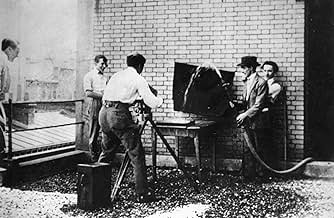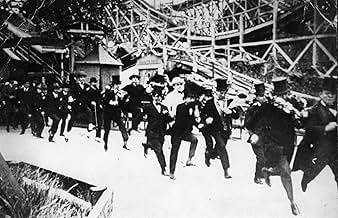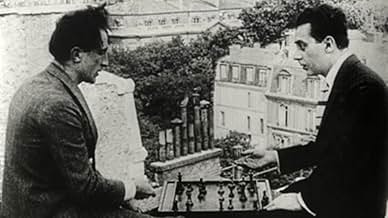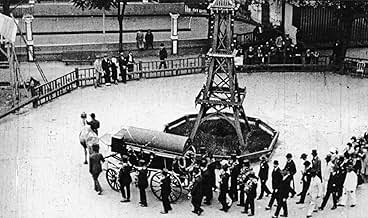Entr'acte
- 1924
- 22min
VALUTAZIONE IMDb
7,3/10
4381
LA TUA VALUTAZIONE
Aggiungi una trama nella tua linguaAn absolute dada movie. Somebody gets killed, his coffin gets out of control and after a chase it stops. The person gets out of it and let everybody who followed the coffin dissapear.An absolute dada movie. Somebody gets killed, his coffin gets out of control and after a chase it stops. The person gets out of it and let everybody who followed the coffin dissapear.An absolute dada movie. Somebody gets killed, his coffin gets out of control and after a chase it stops. The person gets out of it and let everybody who followed the coffin dissapear.
Inge Frïss
- La ballerine
- (as Mlle Frïss)
Man Ray
- Un joueur d'échecs
- (as Man-Ray)
Marcel Achard
- Un homme qui suit le corbillard
- (non citato nei titoli originali)
Georges Auric
- Un homme qui suit le corbillard
- (non citato nei titoli originali)
Georges Charensol
- Un homme qui suit le corbillard
- (non citato nei titoli originali)
Georges Lacombe
- Un homme qui suit le corbillard
- (non citato nei titoli originali)
Roger Le Bon
- Un homme qui suit le corbillard
- (non citato nei titoli originali)
Jean Mamy
- Un homme qui suit le corbillard
- (non citato nei titoli originali)
Rolf de Maré
- Un homme qui suit le corbillard
- (non citato nei titoli originali)
Erik Satie
- Un homme qui charge le canon
- (non citato nei titoli originali)
Pierre Scize
- Un homme qui suit le corbillard
- (non citato nei titoli originali)
Louis Touchages
- Un homme qui suit le corbillard
- (non citato nei titoli originali)
Recensioni in evidenza
Entr'acte is a light-hearted example of Dada cinema of the 1920's. The tone is consistently playful and silly and you can just tell that the film-makers are having a laugh throughout. I'm certainly not too convinced that there is any particular message here. The emphasis of the film is using the cinematic medium to showcase inventive and surreal imagery in an amusing way. The narrative, such as it is, has us follow a funeral march. Although seeing as this is a Dada film, it's not exactly an ordinary march. For one thing it's led by a camel, and for another, the people in the procession bound around in slow motion for no discernible reason other than it looks funny.
The film itself was conceived as something to be shown in an intermission between other films. It clearly was never meant to be taken too seriously, and it's quite obvious that it was made in a way that allowed some of the leading proponents of the Dada/Surrealist movement to have fun and go for laughs. Surrealism was often an art-form with a sense of humour in any case, as anyone familiar with Salvador Dali's work could attest. Like most art films from the 20's Entr'acte has aged remarkably well and like others displays a sensibility that would be replicated many decades later in avant-garde cinema of the 60's and pop videos of the 80's and beyond. All-in-all a fun film to see.
The film itself was conceived as something to be shown in an intermission between other films. It clearly was never meant to be taken too seriously, and it's quite obvious that it was made in a way that allowed some of the leading proponents of the Dada/Surrealist movement to have fun and go for laughs. Surrealism was often an art-form with a sense of humour in any case, as anyone familiar with Salvador Dali's work could attest. Like most art films from the 20's Entr'acte has aged remarkably well and like others displays a sensibility that would be replicated many decades later in avant-garde cinema of the 60's and pop videos of the 80's and beyond. All-in-all a fun film to see.
10m67165
This is it, for me! Absolute pure cinematic fun! This movie is not trying to tell you a story, although there is a plot about a funeral that ends up transforming into some unexpected events. I just had to laugh, and also marvel at some images that are simply beautiful, like some sort of silent visual music.
What the director does is basically a collage of absurd images and some camera tricks. These involve some artists of the time. I must say I am quite surprised by its freshness even today. Now I know where musical video clips come from! The first time I saw it, I was going to see some old silent movies, and this one was shown first, and I had no idea what it was all about. In a way, I still don't, and that's even better! Stop making sense for a while and start the fun!
What the director does is basically a collage of absurd images and some camera tricks. These involve some artists of the time. I must say I am quite surprised by its freshness even today. Now I know where musical video clips come from! The first time I saw it, I was going to see some old silent movies, and this one was shown first, and I had no idea what it was all about. In a way, I still don't, and that's even better! Stop making sense for a while and start the fun!
Rene Clair and the Marx Brothers once decided to make a movie together: it's a shame that it never happened. Maybe that movie exists in some alternate universe, and I'll bet it's hilarious. I enjoyed "Entr'acte", but I'd gladly trade this film for a chance to see Rene Clair's Marx Brothers movie.
Another IMDb reviewer has synopsised the plot, such as it is: a man apparently dies. After his funeral, his coffin escapes from its hearse, and then the man returns to life. The title "Entr'acte" (an interval between theatrical acts, or an intermission) is never explained; maybe it refers to the interval between that man's two lives. I prefer to think that Clair meant this somewhat amateurish film as a mere intermission: an amusing bit of fun between the acts of his 'real' films; the ones with coherent story lines.
Some of the content in this film truly does seem to be unintentional. After the central character's funeral, there's a stiff wind blowing outside the chapel. The women in this movie wear elaborate long dresses, and the wind animates their clothing in a way that's distracting rather than funny, and surely not meant to be symbolic.
Much of the imagery in this movie seems to be pure Dada rather than signifying anything. The man's funeral cortege is led by a camel. If there's any underlying significance there, I doubt that it amounts to much. Earlier on, I was intrigued by one sequence featuring Parisian chess players. While the camera focuses on the chessboard, a shot of Parisian traffic is superimposed: suggesting that all humanity are pawns in some cosmic chess game.
Don't look for too much meaning in "Entr'acte". It's an amusing experiment, but might have been more effective at a shorter length.
Another IMDb reviewer has synopsised the plot, such as it is: a man apparently dies. After his funeral, his coffin escapes from its hearse, and then the man returns to life. The title "Entr'acte" (an interval between theatrical acts, or an intermission) is never explained; maybe it refers to the interval between that man's two lives. I prefer to think that Clair meant this somewhat amateurish film as a mere intermission: an amusing bit of fun between the acts of his 'real' films; the ones with coherent story lines.
Some of the content in this film truly does seem to be unintentional. After the central character's funeral, there's a stiff wind blowing outside the chapel. The women in this movie wear elaborate long dresses, and the wind animates their clothing in a way that's distracting rather than funny, and surely not meant to be symbolic.
Much of the imagery in this movie seems to be pure Dada rather than signifying anything. The man's funeral cortege is led by a camel. If there's any underlying significance there, I doubt that it amounts to much. Earlier on, I was intrigued by one sequence featuring Parisian chess players. While the camera focuses on the chessboard, a shot of Parisian traffic is superimposed: suggesting that all humanity are pawns in some cosmic chess game.
Don't look for too much meaning in "Entr'acte". It's an amusing experiment, but might have been more effective at a shorter length.
Originally played as an intermission with no sound, this film is now a must for any fan/historian of fine art. Featuring cameos by Man Ray, Marcel Duchamp, and other notables, Clair and Picabia's dada collage of different narratives, experimental use of the camera, and surrealist and absurdist images is the best example of experimental or dadaist films from the period. As unusual as it is to watch a film with no sound, the images created by the artists provide an extremely unique experience for the viewer. Fun for anyone, and especially interesting for those acquainted with the artists or the art movements themselves.
This short film was conceived (hence the title) by René Clair as a diversion for the interval of the absurdist-Dadaist ballet "Relâche", with screenplay by Francis Picabia and music by Erik Satie, both artists at the forefront of the contemporary Parisian avant-garde. At the supposed first night performance in 1924, expectant patrons were greeted by locked doors and a notice bearing the single word "Relâche", which is the French word for "No Show". How absurd! Oh what fun!
To accompany the film, Satie composed a striking piece of orchestral music (arguably more significant than that for the ballet itself), and as expected the remastered film now has this added as its soundtrack, and a pretty good job has been made of editing the music to the action on the screen. This latter consists of a medley of surrealist sequences, culminating in a funeral procession, led by a camel, which escalates into a manic chase, intercut with footage from a big dipper. At the end, all the mourners disappear into thin air one by one; the corpse lives on. How significant all this is, as a narrative itself, as well as in the history of cinema as a whole, I am not qualified to comment, but it must have been seen as groundbreaking at the time, as well as good absurdist fun.
At the start of the film is a short sequence of two men firing a cannon from the roof of the Théâtre des Champs-Elysées and jumping up and down, which was shown separately at the opening of the ballet, not as part of Entr'acte. The two men are Picabia and Satie themselves. This footage is especially poignant, as Satie himself was dead within a year.
For Region 2 viewers, Entr'acte is included as a bonus with Clair's much later masterpiece "Les Grandes Manoeuvres".
To accompany the film, Satie composed a striking piece of orchestral music (arguably more significant than that for the ballet itself), and as expected the remastered film now has this added as its soundtrack, and a pretty good job has been made of editing the music to the action on the screen. This latter consists of a medley of surrealist sequences, culminating in a funeral procession, led by a camel, which escalates into a manic chase, intercut with footage from a big dipper. At the end, all the mourners disappear into thin air one by one; the corpse lives on. How significant all this is, as a narrative itself, as well as in the history of cinema as a whole, I am not qualified to comment, but it must have been seen as groundbreaking at the time, as well as good absurdist fun.
At the start of the film is a short sequence of two men firing a cannon from the roof of the Théâtre des Champs-Elysées and jumping up and down, which was shown separately at the opening of the ballet, not as part of Entr'acte. The two men are Picabia and Satie themselves. This footage is especially poignant, as Satie himself was dead within a year.
For Region 2 viewers, Entr'acte is included as a bonus with Clair's much later masterpiece "Les Grandes Manoeuvres".
Lo sapevi?
- QuizThe ballet "Relâche" ("Theatre Closed") premiered at the Théâtre des Champs Elyseés in Paris on December 4, 1924. Based on a book and with settings by Francis Picabia, it was a ballet in two acts commissioned and staged by the Ballets Suédois of Rolf de Maré, with choreography by Jean Börlin. As the title "Entr'acte" implies, this film was shown between the two acts, with music by Erik Satie.
- BlooperObvious stand-in for the close-up of Rolf de Maré getting kicked in head, which sends him (via reverse motion) flying back into the end title. The "kick" itself is clearly achieved through reverse motion.
- Versioni alternativeThere is an Italian edition of this film on DVD, distributed by DNA Srl (2 Films on a single DVD). The film has been re-edited with the contribution of film historian Riccardo Cusin. This version is also available for streaming on some platforms.
- ConnessioniEdited into Avant-garde Cinema (1960)
I più visti
Accedi per valutare e creare un elenco di titoli salvati per ottenere consigli personalizzati
Dettagli
- Tempo di esecuzione
- 22min
- Colore
- Mix di suoni
- Proporzioni
- 1.33 : 1
Contribuisci a questa pagina
Suggerisci una modifica o aggiungi i contenuti mancanti






















